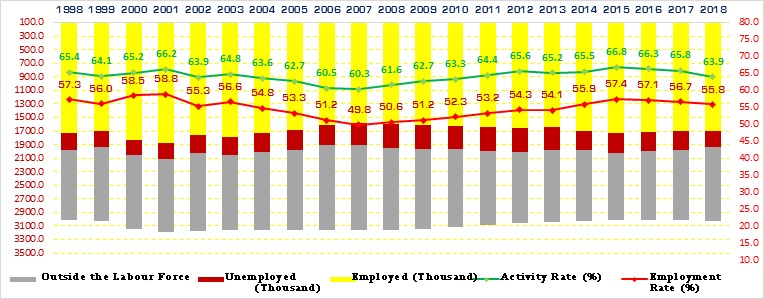Resume: The unemployment rate is defined as the share of unemployed persons in the total labour force (people who are able and willing to work). A person is considered as unemployed if he has been looking for a job during the last four weeks by the time of the National Statistics Office of Georgia’s survey. The labour force is comprised of both employed and unemployed individuals. Therefore, if an individual was not looking for a job in the four weeks prior to the National Statistics Office of Georgia’s survey, he does not participate in measuring the unemployment rate. In turn, the unemployment rate can fall for two reasons: 1. Unemployed people find employment and 2. Unemployed people quit the labour force after looking for a job for a long period of time. The second case does indeed decrease the unemployment rate but the employment rate does not increase. The latter, by itself, is a negative macroeconomic occurrence.
It was precisely for the second reason that the unemployment rate fell in 2018; that is, employment in fact did not increase. The number of employed individuals in the country decreased by 12,400 persons in the course of the last year. Therefore, employment and activity levels are better indicators of the existing reality as compared to the unemployment rate. These indicators have decreased by 1.9 and 0.8 percentage points, respectively. Of note is that the employment rate fell in both 2016 and 2017.
Therefore, as of 2018, the unemployment rate is indeed the lowest in terms of percentage in the last 15 years (it is not historically the lowest figure because the unemployment rate was 10.3% in 2000) and decreased by 1.3 percentage points as compared to the previous year. Therefore, Mamuka Bakhtadze’s statement is literally accurate; however, important context is missing which could have made for a drastically different perception in the public: as we have mentioned, a decrease in the unemployment rate is not related to job creation and increased employment. On the contrary, the number of employed people decreased in that period. A falling unemployment rate might be stipulated by the rise in the number of so-called “discouraged workers.”
Analysis
The Prime Minister of Georgia, Mamuka Bakhtadze, stated: “In parallel with economic growth and development of the business sector, the unemployment rate has been falling in the country. In 2018, the unemployment rate decreased by 1.2 percentage points and reached 12.7% which is the lowest figure in the last 15 years.”
The unemployment rate is defined as the share of unemployed persons in the total labour force whilst the labour force is comprised of employed individuals and those unemployed individuals who are able and willing to work. A person is considered as unemployed if he was not employed in the seven days (even for an hour) prior the National Statistics Office of Georgia’s survey, has been looking for a job during the last four weeks by the time of the National Statistics Office of Georgia’s survey and was willing to take employment in the next two weeks. Therefore, the reason why some part of the working-age population ended up outside of the labour force could cause a rise in the numbers of the “discouraged worker.” This term refers to the issue of working-age people ceasing to look for employment as a result of a long and unsuccessful job search. Therefore, the unemployment rate better reflects the employment/unemployment situation in the country and indicates which part of the working-age population is employed.
The share of unemployed individuals in the labour force was 12.7% in 2018 which is 1.3 percentage points less as compared to the previous year’s figure. However, the decreased unemployment rate was not reflected on the employment rate because the total employment in the country decreased by 12,400 individuals in 2018. The same situation was in 2017 when the unemployment rate decreased by 0.1 of a percentage point as compared to the previous year although the number of employed people also decreased by 10,600. There was a similar situation in 2016 when the decreased unemployment rate was not followed by an increased number of employed individuals. In that year, the number of employed individuals decreased by 16,500 as compared to 2015. This fact also serves as proof that a decreased unemployment rate is not stipulated by positive developments in the labour market. On the contrary, working-age people ending up outside of the labour market in the past three years are called economically inactive working-age people.
The aforementioned trend was confirmed by the Director of the National Statistics Office of Georgia himself who stated: “A rather significant part has moved into the economically inactive segment of the population; that is, the amount of the population outside of the labour force has increased.”
In particular, the number of the working-age population outside of the labour force increased by 12,100 in 2016, by 16,000 in 2017 and the highest figure – at 65,100 – was registered in 2018. It was precisely in the last year when the unemployment rate had the highest drop in terms of percentage whilst the number of working-age people who left the labour force was also the highest. In total, the number of economically inactive individuals increased by 93,200 in the last three years which as of 2018 constitutes 1,094,300; that is, more than one-third of working-age people.
Graph 1: Number of Employed Individuals and Unemployment Rate (Thousand Persons, %)

Source: National Statistics Office of Georgia
Of note is that the share of self-employment in Georgia’s total employment is high. Although this figure has had a tendency of decrease since 2004, the share of self-employment in the total employment constitutes 49.2% as of 2018. In turn, employment in agriculture has a large share in self-employment which is related to free labour in domestic households. In addition, the agriculture sector is distinguished with low productivity which is one the underlying causes of poverty. Therefore, the self-employed are in competition with unemployed people on the labour market which is characterised by mobility in hired employment. However, the number of self-employed decreased by 48,200 in 2018 whilst the number of hired employed persons increased by 35,900 which is lower as compared to 48,200. This means that people from both categories – those employed in the previous year and unemployed – ended up outside of the labour force. The situation was the same in 2017 as compared to 2016.
Of note is that the share of the public sector is high in the growth of hired labour in 2018 because the number of employed in the public sector increased by 19,900 which constitutes a 44.6% contribution to the growth of hired employment. In regard to 2017, employment in the public sector increased by 11,900 which constitutes 52.3% of the total growth in hired employment. Therefore in total and in terms of institutional sectors, employment in the public sector increases whilst employment in the private sector decreases.
As mentioned previously, the situation on the labour market is better reflected by employment and activity levels as compared to the unemployment rate. Owing to the statistical methodology, working-age people end up outside of the labour force because they were not looking for a job in the four weeks prior to the National Statistics Office of Georgia’s survey and, therefore, are considered as unwilling to work (see here for more details).
Graph 2: Structure of Working-Age Population and Activity/Employment Rates (Thousand Persons, %)

Source: National Statistics Office of Georgia








